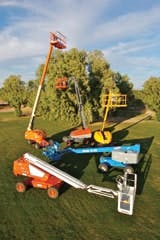The most significant event in the self-propelled-aerial-work-platform industry was the introduction of the JLG 40F in 1976. The brainchild of JLG founder John L. Grove, it was the first mass-produced boom lift. And most would agree this machine is the product that set the aerial-work-platform industry in motion.
Although a dozen brands have emerged at some point since the 1970s, today JLG, Snorkel, Genie, Haulotte, and Skyjack are the sole North American suppliers of straight (conventional) 40-foot boom lifts. This number will grow in 2008 when MEC and, most likely, Aichi introduce their own competing products. It has been years since there were this many competitors in the boom-lift market.
Applications for 40-foot boom lifts, including jib-equipped models, continue to grow, and with that, the number of machines produced also escalates. An estimated 7,000 units are sold worldwide annually. Of these, two-thirds are sold in North America.
In my opinion, the most important design advancements have been to the front drive systems. Early machines were weak-kneed, which hamstrung their potential by limiting application opportunities. The advent of four-wheel drive, first introduced in the early 1980s, helped expand the market. But even early 4x4 machines were anemic when compared to today's state-of-the-art boom lifts. Larger engines, more efficient pumps and drive motors, and advancements in hydraulic engineering have dramatically improved performance.
Small air-cooled gas engines were once the only option. Current selections include a variety of high-output, water-cooled gas engines and high-torque diesel engines. As late as the early 1990s, only 25 percent of these models were delivered with diesel engines. Today, that number has flipped; more than 80 percent are shipped with diesel power plants. Only the need for cleaner-burning propane has kept the gas (dual fuel) engine around.
These progressions have materialized into real advantages. A modern two-wheel-drive machine will go places and climb grades that early four-wheel-drive units couldn't begin to tackle. Nearly 90 percent of all conventional booms produced have this feature, and all of the Boom Lift Showcase machines were four-wheel-drive units. Further advancing drive capabilities has been the development of the oscillating axle, represented here by products from JLG, Genie and Skyjack. To demonstrate the impressive rough-terrain capabilities these boom lifts can deliver, we asked our participants to negotiate a challenging course.
Although the grade was tough — estimated at 25 degrees — gradeability is not the sole attribute of a competent drive system. An effective drive system has what I call “tractionability.” All the power in the world cannot overcome an unbalanced drive system. The dirt here was so loose and sandy that on the following day, several compact telehandlers were unable to climb the grade. Instead, their drive wheels lost traction, spinning helplessly.
While all five units exhibited more than adequate power, the JLG 400S, Genie S-45, and the Skyjack SJ 45T delivered eye-opening performances. Their oscillating axles assisted greatly in being able to drive up and crest the hill, never once hesitating or losing traction.
Less significant than the drive advancement has been the introduction of the jib extension. Although this feature is offered by all the manufacturers, Genie, Skyjack, and Haulotte were the only Showcase units equipped with jibs. Although the concept of a jib — usually 4 to 6 feet in length — was intended to offer an expanded range of motion, the real advantage is the extra reach it delivers.
In addition to challenging the drive systems, we also verified several key specifications. Refer to the chart on page 11 to see the results of Lift and Access' verification of GVW, horizontal and vertical reach, and overall stowed dimensions. The staff also checked drive speeds and boom operational speeds, which are central to measuring a boom lift's productivity.
The Walk-Around Presentations were a key part of the Boom Lift Showcase. Each OEM was given the opportunity to “sell” the features and benefits of its machine to the assembly. A Q&A period followed each presentation. Significant points made during the presentations are summarized in the following individual machine reviews. These presentations along with highlights from the event can be seen in their entirety on the Lift and Access Showcase DVD.
The concept of putting a worker safely 40 feet in the air has never changed — what has changed are the ways the machines are designed and built. These modifications have driven the opening of new application opportunities and have served to further advance market acceptance.





